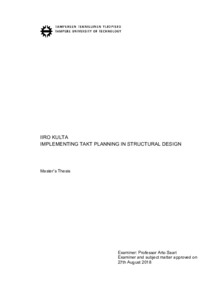Implementing Takt Planning in Structural Design
Kulta, Iiro (2018)
Kulta, Iiro
2018
Rakennustekniikka
Talouden ja rakentamisen tiedekunta - Faculty of Business and Built Environment
This publication is copyrighted. You may download, display and print it for Your own personal use. Commercial use is prohibited.
Hyväksymispäivämäärä
2018-09-05
Julkaisun pysyvä osoite on
https://urn.fi/URN:NBN:fi:tty-201808212182
https://urn.fi/URN:NBN:fi:tty-201808212182
Tiivistelmä
This Master’s Thesis covers how takt planning has been used in manufacturing and construction production, and how it could be applied to structural design. The objective of the study is to develop a proposal for a concept where takt planning is implemented in the target company’s structural design processes and other lines of business, with the help of a literature survey, interviews, and workshops. Takt is based on lean principles and it has been successfully used as a production management and control method in several construction projects around the world. Takt has pointed out to be extremely useful in projects with high level of repetitiveness. Structural design, however, is iterative by nature, thus it differs from construction production in many ways. Unlike construction production, design is not a straightforward process and the focus is rather on making the information flow. This requires broad understanding of the project and constant collaboration within the major project participants. At an operational level, the problems in design will typically result in various harmful consequences. Catenating construction project’s design and production as separate sequential phases may cause non-ideal solutions, poor feasibility of drawings, high level of unnecessary adjustment work, and absence of continuous improvements. Thus, optimizing the design processes to the utmost should not be the most important goal when takt planning is implemented in structural design. More important is good planning and management of own work, i.e. scheduling and resourcing of the commission, daily internal management, and required adjustment mechanisms to achieve the goals. The study implies that implementing takt planning in structural design, or in any other de-sign process, is possible yet challenging. If the owner of the project decides to utilize takt planning at an early stage of the project, the decision will work as a prerequisite for many other decisions, contracts, and working methods to come. This means that comprehensive construction management commissions enable effective implementation of takt planning in both construction production and design. The implementation should not be done unconditionally, but rather by means of well-managed prerequisite demands, pull from the construction production, and project-pulled systems stemming from customer demands. Thus, right now the most essential goal is to enhance organizations to comprehensively understand the benefits of the lean philosophy and takt planning. Due to the limitations of time and scope reserved for the Thesis, the author developed and reported only one way to utilize and implement takt planning in structural design. To get the best results out of the target company’s Lean Development Project, a greater number of potential solutions should be developed. In addition, future research should be conducted about construction projects’ prerequisite management, and the construction industry’s shift from the product perspective to the process perspective.
